Her son's autism sparked a mission to help other parents feel less alone
Overwhelmed by the high costs of autism therapy and resources, Nurul Dhamirah started an Instragram page to share her journey, wrote a book, and created visual cards for her son and other non-verbal kids on the autism spectrum. She tells CNA Women how therapy is crucial and how she’s supporting this cause.
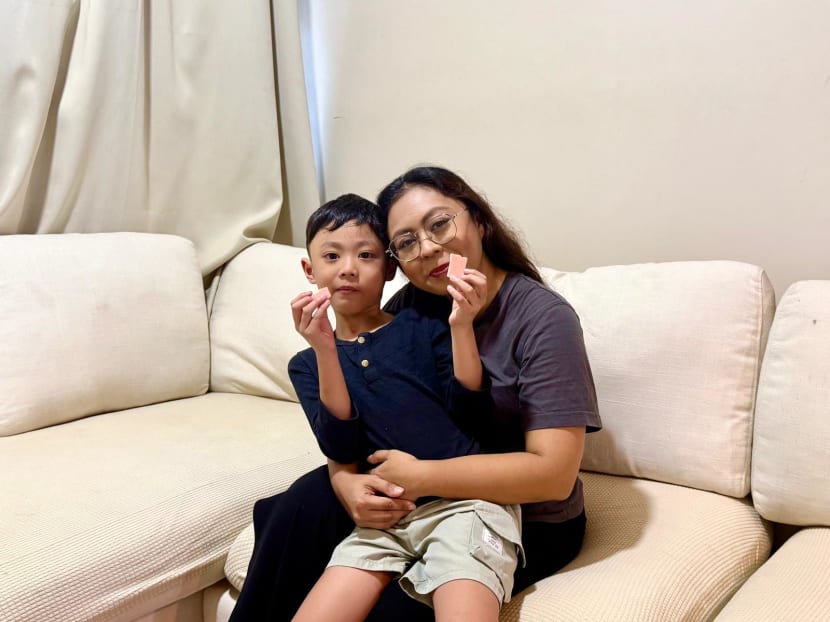
Nurul Dhamirah (right) first noticed signs of autism in her son Adam when he was 18 months old - he was not talking at all and did not respond to his name. (Photo: CNA/Nashita Farveen)

This audio is generated by an AI tool.
Nurul Dhamirah Adam never wanted children. In fact, when she married her husband Muhammad Fazli in September 2017, she had even asked him if it was a dealbreaker.
But he accepted her decision and the two started building a life together without the expectation of parenthood.
Five months into their marriage, however, Dhamirah, 31, found herself staring at a positive pregnancy test. She was two months pregnant. It was not what she had planned, but her initial shock gave way to quiet excitement and she began to embrace the unexpected journey into motherhood.
She gave birth to her son Adam Rizq in 2018.
In 2020, when Adam was 18 months old, Dhamirah and Fazli had a second child, a daughter. During her confinement, Dhamirah noticed something different about Adam, and a creeping worry started to form.
“I saw other kids around Adam’s age talking. And I thought, why are the other kids talking? He is already 18 months old and he is not even talking at all.”
The quiet observation turned into late-night sessions on the internet, researching children’s milestones and trawling through parenting forums. She discovered that, according to developmental guidelines, most toddlers should start speaking at least a few words by the age of 18 months.
Dhamirah and Fazli then came across an online autism screening test and decided to try it with Adam. One of the questions was, “Does your child respond to his name?”. Adam did not respond, Dhamirah said.
“It also asked if there was any joint attention and we noticed how he played. He did not even come to ask, Mummy, do you want to look at this or that. There was no eye contact and he was also unable to jump,” she added. Joint attention refers to a child’s ability to coordinate his or her attention with others and share the same experience.
Each checkbox they couldn’t tick was another knot in her chest. Her mother’s intuition kicked in: Adam might have autism.
NAVIGATING THE WORLD OF AUTISM
Dhamirah took Adam to the nearby polyclinic to clear her doubts in March 2020, and was referred to the KK Women’s and Children’s hospital (KKH) for a specialist evaluation.
However, the wait for the appointment was five months. To the couple, every day felt like a missed opportunity for Adam to progress.

During that time, they came across Applied Behaviour Analysis (ABA) therapy, a form of early intervention that uses reinforcement strategies to help children with autism improve their communication and behavioural skills.
Without hesitation, they enrolled Adam in a home-based ABA therapy session in June 2020, even though the cost was steep – fees can go up to S$1,200 a month for eight two-hour sessions. But to Dhamirah and Fazli, it was necessary.
“When he started therapy, my only question was, will he start talking, because that was my goal,” she said.
“That’s when the therapist told me something very important that hit me: If he can’t learn to listen to understand, he won’t learn to talk.”
Dhamirah came to understand that autism is not a disease to cure but a neurological difference to be supported through the right interventions. “[At first] I even changed his milk, thinking it would make a difference,” she told CNA Women.
“There’s a lot of misconception where people might think when you send your child for therapy, you are changing your child. But it’s not about changing, it’s about improving their behaviour,” she added.
Within the first month of therapy, Adam began making eye contact. The therapists also worked on his motor skills, teaching him how to hop, something that once seemed impossible.
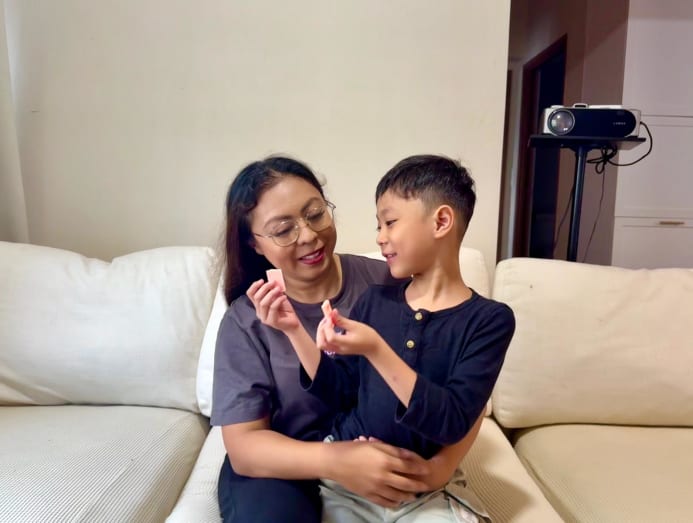
In August 2020, Adam had his specialist evaluation at KKH. There, doctors observed that he had signs of autism and asked the couple if they wanted to have him diagnosed.
“There are parents who diagnose their children as young as three years old but I didn’t want to diagnose him just yet because I felt he was still young and I was still in denial,” said Dhamirah.
Adam was referred to the Early Intervention Programme for Infants and Children (EIPIC), a government-funded programme that provides early intervention services for children under seven who have developmental delays and disabilities.
But once again, the couple found themselves facing another long, agonising wait. They were told that securing a spot in the programme could take anywhere from six to 12 months.
Adam eventually secured a place in Metta Preschool in March 2021, one of the centres offering EIPIC. He attended twice-weekly sessions there, in addition to his ABA therapy and mainstream kindergarten.
Dhamirah explained that the speech and occupational therapists at Metta Preschool worked with Adam on areas such as his stimming – a form of self-regulatory behaviour that children with autism tend to do to help them regulate their emotions.
“For Adam his flapping and head shaking [his stimming] went away over time,” she added.
Within two months, Adam said his first word, “purple”. Soon after, Dhamirah noticed him calling her “Mama” and initiating conversations.
Dhamirah was then working at a bank, and Fazli was a police officer, and the mounting cost of Adam’s therapy was taking a toll on them. To make ends meet, they started a home-based business, Ayam Warrior, selling halal homemade marinated chicken wings and pastes.

ADAM’S DIAGNOSIS WHEN HE WAS FIVE
Adam was assessed for autism in December 2023, when he was five years old – it was a moment Dhamirah had both anticipated and dreaded.
“We went for the diagnosis. I was in the room, but I was not allowed to say anything. I just had to watch,” she recalled.
While Adam was able to complete tasks such as matching cards and building words, there were also areas where he struggled.
“For example, there was a ball that was rolling on the table, and it fell to the floor, and he did it over and over again,” Dhamirah said. The therapist flagged this as stimming behaviour.
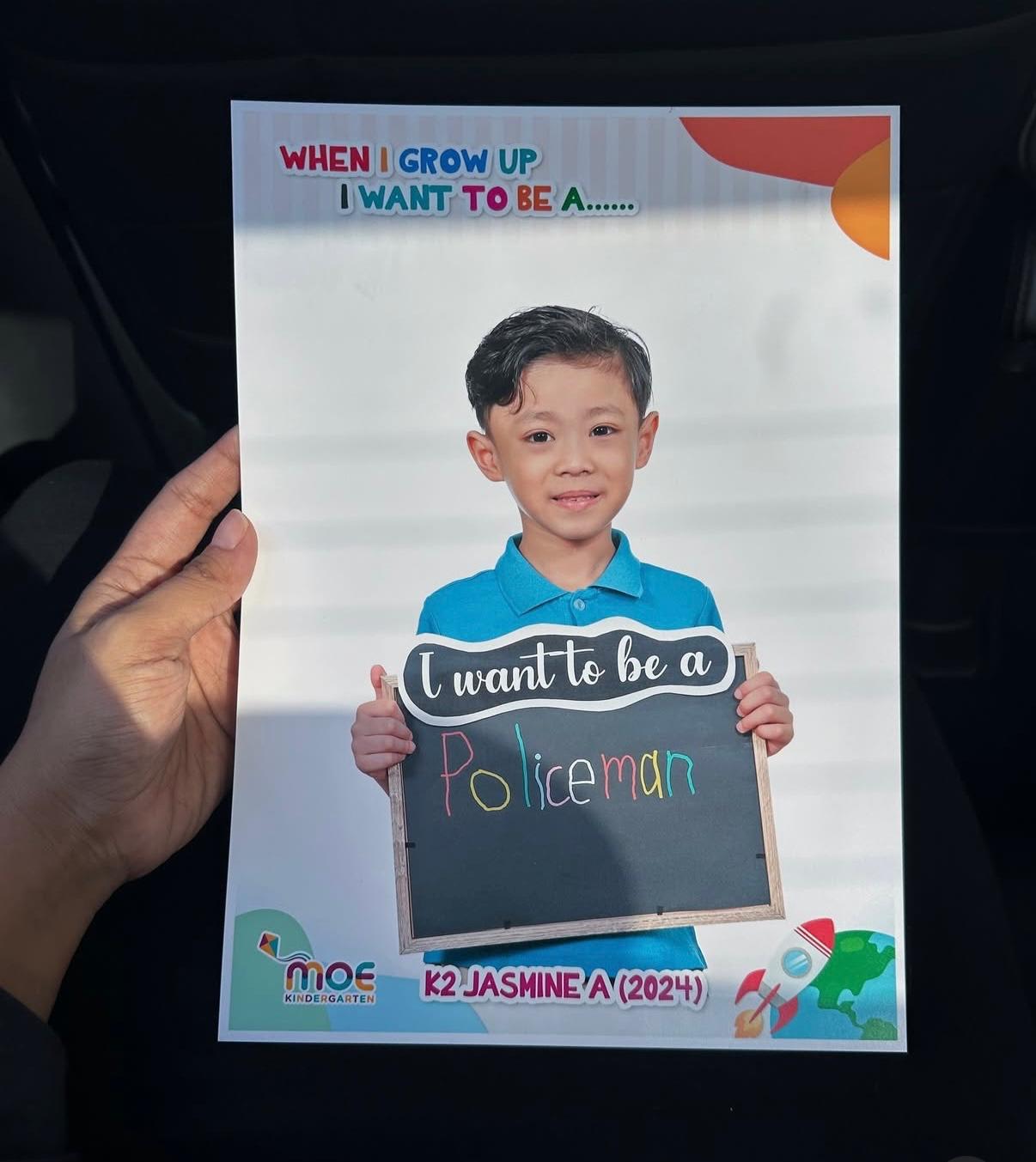
At the end of the session, Adam was diagnosed with Autism Spectrum Disorder, Level 2.
“The label didn’t define him, but it helped me understand him better,” said Dhamirah.
She explained that at Level 2, Adam showed strengths in areas like writing, spelling and remembering numbers. However, he needed guidance with his social skills, such as holding conversations, as well as everyday tasks such as gripping utensils and feeding himself.
UNDERSTANDING HER SON – AND HERSELF
For Dhamirah, the journey through autism wasn’t just her son’s – it became her own. She struggled with self-doubt, often breaking down in tears late at night, wondering if she was doing enough.
Despite having a strong support system, she felt alone in her journey.
“I feel like if there was another parent who actually stepped out of their comfort zone to share what they go through with their child, it makes another parent feel less lonely in their journey,” said Dhamirah.
She also noticed a lack of awareness and empathy from the public, with strangers giving judgemental stares when Adam had meltdowns, and having to repeatedly explain his condition to relatives who did not understand what autism is.
That’s when Dhamirah decided to start an Instagram page, @adamautismawareness, in August 2022, to document Adam’s journey and raise awareness about autism.
“People started to relate to my content and reached out to me,” said Dhamirah. “There were so many people out there who were in the same boat or felt lonely in their journey.”
Most of the parents were seeking comfort while others were looking for answers, from how to handle meltdowns to toilet training, and even advice on how to set a sleep routine for their children. She now has over 38,000 followers.

Among the concerns, one recurring issue stood out: The lack of accessibility to, and the high cost of, therapy.
“Early intervention is important because if there is no therapy, they wouldn’t be able to progress. These parents are missing out on years of early intervention, when that phase is so crucial for the children,” said Dhamirah.
She said that even when therapy or a school was available, it was not enough, and parents had to be consistent by having the right tools to help their children at home.
MY FIRST VISUAL CARDS: A TOOL TO HELP OTHER PARENTS
In May this year, Dhamirah designed a set of visual communication cards for non-verbal children on the autism spectrum.
My First Visual Cards offer parents a way to support their children at home, especially those who cannot afford therapy or whose child is falling behind due to the long waiting period for an intervention programme.
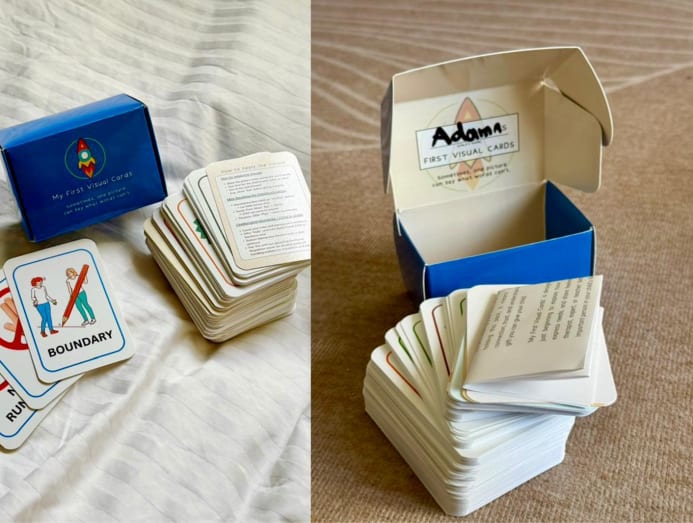
She was first introduced to the concept during Adam’s ABA sessions, where visual cards were a compulsory tool.
"Visuals were a core process throughout Adam’s journey and children with autism generally thrive on visuals,” she said.
Dhamirah explained that children with autism struggle to express their needs, and this often leads to intense frustration, for both the child and parents.Visual cards help the child initiate conversations, which allow parents to better understand their needs.
“Maybe your child is having a meltdown and he doesn’t want to wear shoes. It may be because he doesn’t know where he is going. So you can actually do a visual board using the cards to break down what they should be doing and where they are going.”
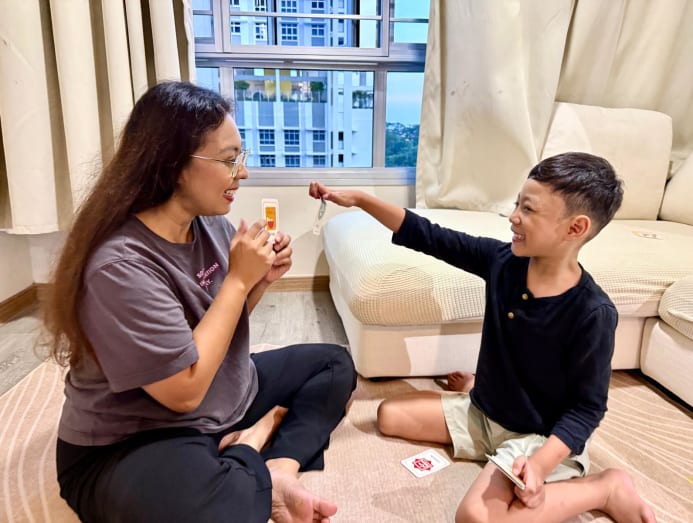
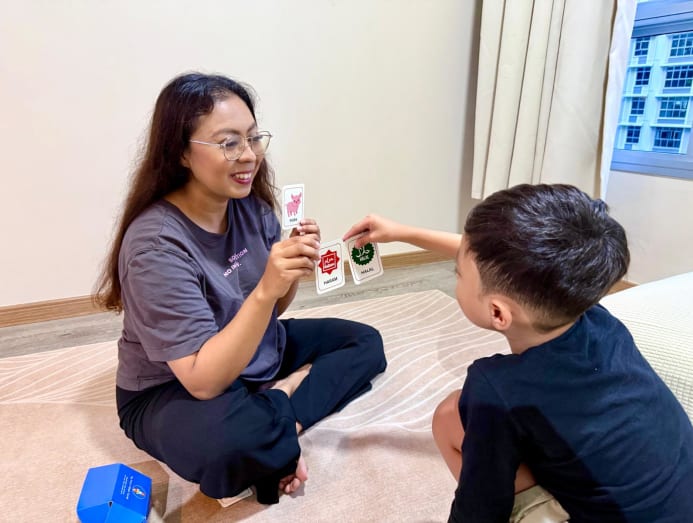
The ones she created are organised into practical segments including communication skills, learning, and behavioural support - a structure borne from her own experience with the original therapy cards she bought for Adam.
Those had limitations, she said. For one, there was no logical breakdown or usage instructions. They were also costly.
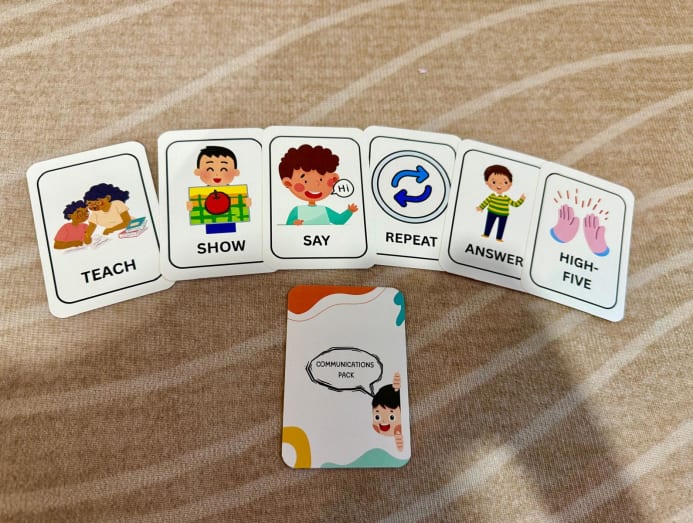

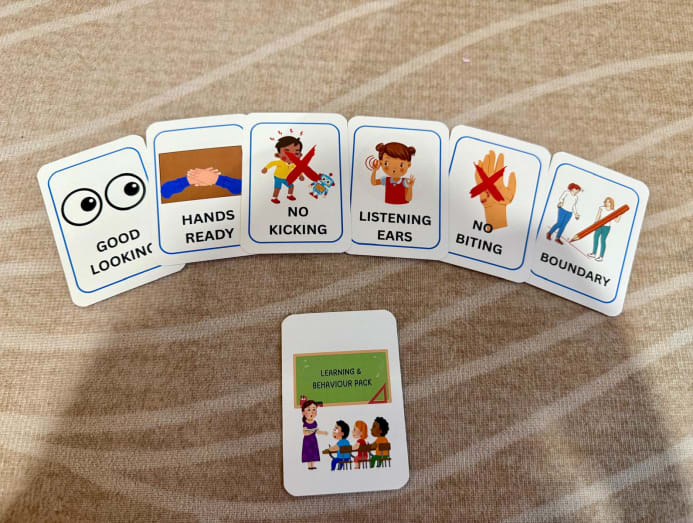
Dhamirah's My First Visual Cards comes in two formats: A digital printable set for S$24.90, or a physical version, for S$79.90.
She knew that simply handing parents a tool was not enough. Thus, she went a step further: each set includes tips such as creating interactive games with the cards, follow-up emails and a full workflow that walks parents through how to use the cards.
AUTISM UNVEILED: HER OWN MOTHERHOOD JOURNEY
Prior to launching the visual cards, Dhamirah published an e-book titled Autism Unveiled in April as an homage to her motherhood journey. She has since sold over 200 copies.
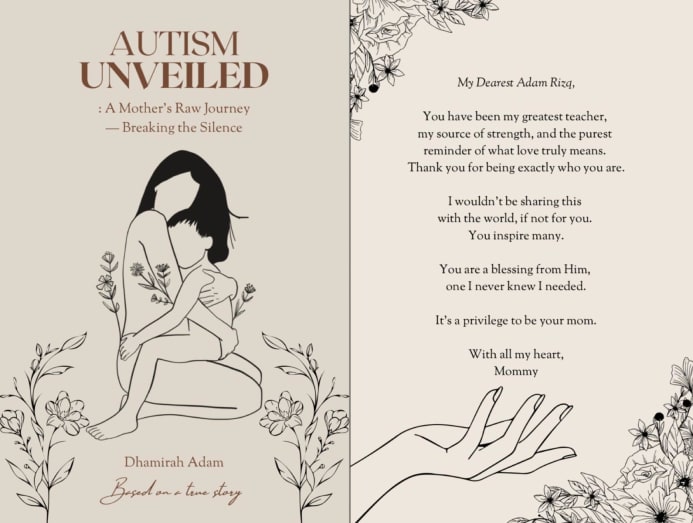
In her book, Dhamirah opens up about her experiences as a mother raising a child with autism. She also delves into personal aspects of her life – her previous miscarriage, the emotional toll of being a working mother and the identity struggles she faced along the way.
“I just wish for more mums to feel seen, understood and heard, that we are all on a journey together,” she said.
She also hopes that through her book, other parents can navigate the grief that comes with raising a child with special needs.

Dhamirah doesn't plan to stop here. She is now working on creating more tools to support parents, including resources on toilet training and emotional regulation.
Today, she is inspired by Adam’s remarkable progress. Once completely non-verbal, he began his primary education at a special education school in January. While he was assessed suitable for mainstream education, Dhamirah believes the focus on life skills in a special education school will empower Adam to thrive in the long run.
“I feel if you have life skills, you can be anything you want. I won’t force him to go a certain route, he can decide that for himself.
“Some parents might think that autism is the end of the road. But that might be because you’re still grieving and not in the acceptance phase. You’ve lost hope and given up believing in what your child is capable of achieving,” said Dhamirah.
“It’s our mindset and perspective that needs to shift for us to learn how to adapt into their world and work towards their strengths. Every small milestone of theirs is our biggest win.”
Related:
CNA Women is a section on CNA Lifestyle that seeks to inform, empower and inspire the modern woman. If you have women-related news, issues and ideas to share with us, email CNAWomen [at] mediacorp.com.sg.






